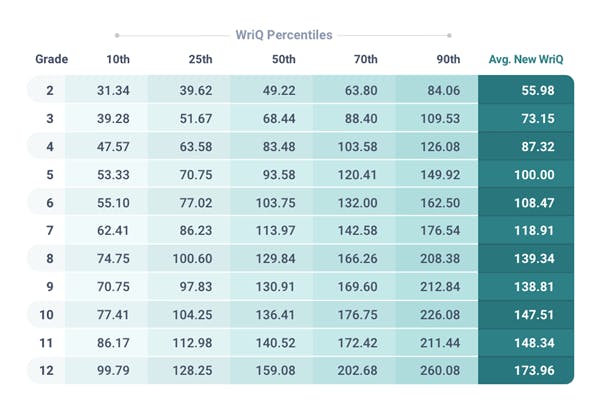What's the WriQ score?
The WriQ score is a recognized writing standard that establishes common expectations for writing assessment and achievement at a state or national level.
The WriQ norms are based on over 100,000 writing samples from students across all grade levels. This national norms comparison (combined with several other useful metrics) allows WriQ to provide a meaningful score that helps teachers assess how well their students are writing compared to other students in their grade.

To help understand how the WriQ score was developed, it will be helpful to look at a related field: assessing reading fluency. Books and reading passages are commonly sorted by Lexile level. As you’re probably aware, the Lexile level indicates the complexity of the text being read or assigned.
When measuring a student’s reading fluency, an appropriate passage is chosen based on Lexile level. A teacher then typically listens to the student read that passage to establish how many words they are reading correctly per minute. This provides a “correct words per minute,” or CWPM, score.
The researchers Hasbrouck & Tindal have done an excellent job in creating a norms chart that explains how many words correct per minute a student should be reading based on their grade and the time of year. This means that if you calculate a CWPM score for a student you can instantly know if a student’s reading ability is on target, ahead of the class, or if that student is struggling to keep up with their peers.
So what about writing assessment?
Until now, there hasn’t been an equivalent to Lexile levels or established norms for writing, so measuring the success of students, schools, and districts with writing and writing instruction has been extremely difficult, if not impossible. That’s where the WriQ score comes in.
When considering a student’s writing, and comparing the metrics of their writing to other students in their cohort group, it can be helpful to consider :
- Accuracy - Their grammatical accuracy - how many correct word sequences did they create?
- Maturity - How does their vocabulary maturity compare with the national norms?
- Diversity - Lexical Diversity is a measure of how many different words are used in a text. It is a good measure of how complex a piece of writing is.
Diversity and accuracy are well-established measures of student writing progress, and they have been widely adopted in many writing assessment applications. The standard measure for productivity and accuracy when writing is generally referred to as “Correct Word Sequences” (CWS) and “Incorrect Word Sequences” (IWS). To understand these measures, think of any two words together forming a sequence. If one of the two words is incorrect in some way it makes that sequence incorrect. The more correct word sequences (and fewer incorrect word sequences) the better.
Technology-assisted assessment
The calculation of CWS and IWS scores by teachers has been such a slow and laborious process that to date they have been impractical to use in today’s classroom. Teachers simply don’t have time.
However, changes in available technology have made it possible to automatically:
- Estimate the CWS and IWS measures and make it simple for teachers to modify those estimates - removing the time-consuming “busy work” of counting these sequences. This greatly simplifies assessing student writing for accuracy.
- Track the number of different words divided by the number of total words, providing an accurate measure of diversity/complexity.
- Provide an assessment of text maturity compared to national norms.
Tying these scores together allows WriQ to display a single score (on a 0-400 scale) that gives educators a much more accurate picture of student writing achievement and progress. And because the WriQ score has been developed based on established research and over 80,000 student writing samples, it also provides a national comparison (similar to Hasbrouck & Tindal’s oral reading fluency norms) based on a student’s grade level and how far into the school year they are.
By tracking these scores over time, teachers can get an incredibly accurate prediction of how well their students will do on standardized exams, state summative exams, and even how they will fare as writers at the next grade level. The Norms chart for WriQ Scores is below.
Please let us know if you have thoughts, questions, or ideas on how we can make this metric more useful for you or your students.
